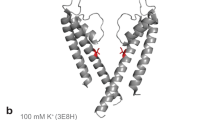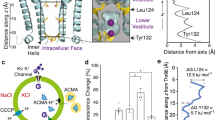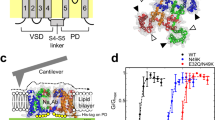Abstract
Many transport processes in biological membranes show a saturation of transport rate when the concentration of the transported ions or molecules is sufficiently increased. Saturation will result when at high concentrations a translocation step which does not directly depend on bulk concentration becomes rate limiting, and it is expected for all multi-step translocation mechanisms. However, a possible alternative explanation for saturation is a regulatory process which decreases the number of translocating channels in response to an increase in bulk concentration of the transported species. In the frog epidermis, Na+ uptake from the extracellular space into the epithelial cytosol occurs through Na+-selective, passively conducting channels located in the apical membrane of the cells directly below the cornified outer cell layer. Saturation of transport occurs with increasing outer Na+ activity ([Na]o): the net Na+ current1,2, membrane conductance2,3 and unidirectional Na+ influx4 increase only subproportionally with [Na]0. The apical Na+ current can transiently be larger than the saturation value, suggesting that a fixed upper single channel transport rate is not responsible for the saturation, and it has, therefore been suggested that in this case saturation occurs through a [Na]o-dependent decrease in channel density2. The Na+-translocation process can be investigated by a statistical evaluation of spontaneous transport fluctuations. The reversible transport blocker amiloride can be used to induce random fluctuations of the Na+ current at the apical membrane. The power density spectrum of these fluctuations is of the lorentzian type and permits an estimation of the Na+ current which passes through individual translocators in the time intervals between blocks5. We have recorded the current fluctuations at different [Na]o values and different amiloride concentrations in the [Na]o range in which saturation of total Na+ current is observed. We report here that the density of the conducting pores decreases with increasing [Na]o.
This is a preview of subscription content, access via your institution
Access options
Subscribe to this journal
Receive 51 print issues and online access
$199.00 per year
only $3.90 per issue
Buy this article
- Purchase on Springer Link
- Instant access to full article PDF
Prices may be subject to local taxes which are calculated during checkout
Similar content being viewed by others
References
Cereijido, M., Herrera, F. C., Flanigan, J. W. & Curran, P. F. J. gen. Physiol. 47, 879–893 (1964).
Fuchs, W., Hviid Larsen, E. & Lindemann, B. J. Physiol., Lond. 267, 137–165 (1977).
Gebhardt, U., Fuchs, W. & Lindemann, B. Role of Membranes in Secretory Processes, 284–300 (North–Holland, Amsterdam, 1972).
Biber, U. L. T. & Curran, P. F. J. gen. Physiol. 56, 83–99 (1970).
Lindemann, B. & Van Driessche, W. Science 195, 292–294 (1977).
Owen, H. The Physical Chemistry of Electrolytic Solutions (Reinhold, New York, 1967).
Van Driessche, W. & Lindemann, B. Rev. scient. Instrum. 49, 32–37 (1978).
Van Driessche, W. & Gögelein, H. Nature 275, 665–667 (1978).
Author information
Authors and Affiliations
Rights and permissions
About this article
Cite this article
Van Driessche, W., Lindemann, B. Concentration dependence of currents through single sodium-selective pores in frog skin. Nature 282, 519–520 (1979). https://doi.org/10.1038/282519a0
Received:
Accepted:
Published:
Issue Date:
DOI: https://doi.org/10.1038/282519a0
This article is cited by
-
Effect of oxytocin on transepithelial transport of water and Na+ in distinct ventral regions of frog skin (Rana catesbeiana)
Journal of Comparative Physiology B (1996)
-
Effect of dexamethasone on sodium channel block and densities in A6 cells
Pflügers Archiv (1995)
-
Regulation of Na+ channels in the cortical collecting duct by AVP and mineralocorticoids
Kidney International (1992)
-
Amiloride blockage of Na+ channels in amphibian epithelia does not require external Ca2+
Pflügers Archiv (1991)
-
The key role of the mitochondria-rich cell in Na+ and H+ transport across the frog skin epithelium
Pfl�gers Archiv European Journal of Physiology (1989)
Comments
By submitting a comment you agree to abide by our Terms and Community Guidelines. If you find something abusive or that does not comply with our terms or guidelines please flag it as inappropriate.



